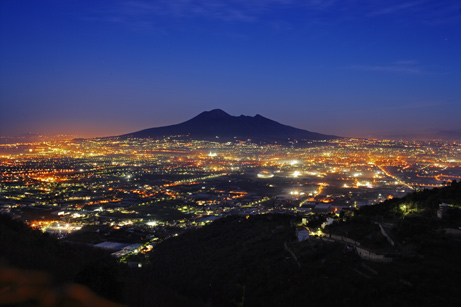The block of Vesmasius is emerging
The magma beneath the Vesuvius mountain range has been rising to the surface in more than 20,000 years, according to a new study.
This finding may be good news for about 3 million volcanic people operating in Campania, Italy, where Vesuvius's geological event in 79 AD buried Pompeii and Herculaneum.
Macma at a shallow depth is more difficult to evaporate and less likely to form violent eruptions, according to the research team led by Bruno Scaillet of the University of d'Orléans, France.
The magma mine contains a continuous amount of lava that is accreted and emitted when the volcano erupts. The location of the magma mine as well as its characteristics is the focal point to understand the severity of future eruptions
Scaillet said: 'There is a difference in depth pressure between the Pompeii event and the more recent eruptions, our experiments show that future eruptions will be very different from the one that destroyed Pompeii' .
Stone reveals the rise of magma
Scaillet studied lava rocks created from four historical eruptions and at recreating the magma's temperature and pressure during those events.
Data show that, since the event of the year 79 AD and an eruption in 472 after technology, the block of magma rose up, from 4.4 to 5 miles (7-8 km) below the surface to 1.8-2.5 miles (3-4 km).

The Vesuvius Range loomed above the Italian city in a photograph that did not contain a date.The September 2008 study said Vesuvius' s magma was emerging, promising less intense eruption in the future.(Photo: nationalgeographic)
Scaillet said there is no information about whether the magma continues to rise since the latest eruption or its size today, but near-surface magma creates less intense eruptions.
He added, 'The later the magma, the thicker the magma is and the cooler,' he explains that such types of magma tend to cause intense eruption when they reach the surface '.
It is likely that Vesuvius will erupt in the future.
This mountain is believed to have caused major eruptions 22,500 years ago, 17,000 years, 15,000 years, 11,400 years, 8,000 years, 3,780 years, and 2,000 years.
Full of risks
Michael Sheridan, a volcanic researcher at the University of Buffalo in New York, said the study was interesting.
Sherdian, who is not involved in the study, said: 'It represents a new aspect. Geochemistry is an interesting field, and I am very happy that it is interested in discussing '.
Sheridan, however, studied the effects of volcanic eruptions on residential areas, warning that this study is not the last to predict the huge risks that exist in parallel with Vesuvius.
He stressed that other volcanic eruption data, such as sediment distribution and tectonic factors, are not in the study.
He said:
'This is another model. We need to develop a plan that will prompt multiple explanations at the same time and somehow incorporate the consequences of all those hypotheses. '
- 70% of emerging infectious diseases are caused by animal transmission
- 500 million year old stone block balancing in the depths of thousands of meters
- 'Secrets' of the standard mass of US stored in a vacuum glass cage
- Australian man dug 4kg gold block
- Brazilian miners discovered precious precious jade weighing 3.6 quintals
- Snow cubes curled between Scottish fields
- Video: Conquer the world's hardest Rubik's block
- UNESCO: 'Emerging countries take advantage of R&D'
- Emerging newborn island in Japan can 'live long'
- Detecting stone slabs emerging images of Vietnam map
- A large block of ice separates from Antarctica
- The origin behind Laurel and Yanny: the most popular phenomenon on the Internet this week
 Is the magnetic North Pole shift dangerous to humanity?
Is the magnetic North Pole shift dangerous to humanity? Washington legalizes the recycling of human bodies into fertilizer
Washington legalizes the recycling of human bodies into fertilizer Lightning stone - the mysterious guest
Lightning stone - the mysterious guest Stunned by the mysterious sunset, strange appearance
Stunned by the mysterious sunset, strange appearance